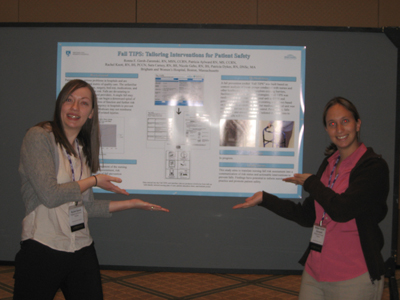Nurse-Led Research Study on Falls Published in JAMA

Rachel Pozzar and Ronna Zaremski showcase their poster.
Nurses on Tower 14CD, an intermediate medicine unit, typically have opportunities to participate in pilots for many projects and research studies, but they recently felt fortunate to be part of their first nurse-led study on interventions to reduce patient falls.
The findings, which show a reduction in the number of older patients with falls in hospitals, were reported in the Nov. 3 Journal of the American Medicine Association, a theme issue on aging.
“Falls are a public health problem worldwide,” said lead author Patricia Dykes, DNSc, RN, who joined BWH’s Center for Nursing Excellence as a senior nurse scientist in November. “Hospitalization increases fall risk because of the unfamiliar environment, illnesses and treatments. A single fall may result in a fear of falling and begin a downward spiral of reduced mobility, leading to loss of function and greater risk of falls.”
The study, which took place in units at four Partners HealthCare hospitals, may be the first fall prevention clinical trial that provides evidence for using a specific health information technology intervention to reduce falls in short-stay hospitals.
When beginning this research in 2008, Dykes knew it would be critical to the study’s success to ensure that nurses were involved and engaged from the start. With the help of leadership, including Escel Stanghellini, RN, Quality program director of Hematology/Oncology/BMT, initial focus groups recruited about 30 nurses and other care team members from BWH to discuss fall interventions already in use and barriers to their success.
“This was really instrumental,” Dykes said. “We defined our protocol from what we learned in these groups. It was very clear that nurses wanted to integrate our tool into the context of their regular workflow, rather than add extra steps or introduce something completely different.”
Dykes and her team used health information technology to create a fall prevention toolkit consisting of a fall risk assessment, patient-specific prevention plan, an educational handout and a poster for over the patient’s hospital bed.
At BWH, the toolkit was built into eMAR so that nurses could fill out the Morse Fall Scale electronically. The application developed by the research team took that information and translated it into a list of specific interventions for each patient, such as “needs cane to walk to bathroom,” or “needs assistance getting out of bed.”
“The tailored interventions were really helpful,” said Ronna Zaremski, MSN, RN, CCRN, nurse educator for Tower 14CD. “There’s a big difference in fall risk for an elderly patient with a gait disturbance versus a 25-year-old patient on morphine.”
Prior to the study, nurses filled out a paper version of the Morse scale to come up with a number that signifies whether a patient is at risk. Each room has a “Call, Don’t Fall” sign to prevent falls in general and a “High Risk Fall” sign to indicate patients who have a risk of falling.
Dykes’ toolkit provided nurses with a poster featuring pictures of each intervention required, based on how they filled out the electronic Morse scale. Nurses hung the poster over the patient’s bed and also used an educational handout, provided through the toolkit, with similar information to use when educating patients and their families about their specific risks and interventions.
“This toolkit incorporated nurses’ critical thinking with technology to reduce patient falls,” Zaremski said. “The poster was especially helpful because so many people answer the call bells and the person answering might not know the patient as well as the primary nurse.”
In addition to Zaremski, three staff nurses were identified as champions to encourage use of the toolkit: Nikki Shanley, BSN, RN; Rachel Pozzar, BSN, RN, PCCN; and Sarah Imparato, BSN, RN, PCCN.
“I think one of the reasons our study was so successful is because it was embraced by staff nurses, thanks to our champions and leadership,” Dykes said. “Nursing Director Pat Aylward was amazing in her involvement.”
After the intervention period, the researchers found that fewer patients had falls in intervention units than in control units. Analysis indicated the intervention units had a significantly lower adjusted fall rate than control units. The researchers also found that the intervention was significantly better for older patients but had no effect in younger patients. No significant effect was noted in fall-related injuries.
The authors calculated that just for the eight units involved in the study, the fall prevention toolkit could potentially prevent one fall every four days, seven and a half falls each month and about 90 falls each year.
“Our findings provide evidence that this type of program, which tailors interventions to address patient-specific determinants of risk and is implemented within existing workflows, is effective in acute care hospitals with older adults,” Dykes said.
“Further study is needed to determine if a similar program evaluated over a longer period of time can significantly reduce repeat falls,” she added. “Moreover, work is needed to develop a set of interventions that will prevent fall-related injuries. However, the fall prevention toolkit was effective at reducing numbers of falls in intervention vs. control units.”
In addition to its important patient safety findings, the study also helped catalyze an interest in research among nurses who were involved.
During and after the study, nurses from 14CD created posters for presentation at conferences including Nurses Improving Care for Health System Elders (NISHE) in Orlando, the New England Nursing Informatics Consortium (NENIC) and a Partners HealthCare summit on patient falls in 2009.
“We got incredible feedback when we presented this study at each conference we attended,” Zaremski said. “It was great for so many of us to be involved in creating posters and presenting on research, and we were all excited that this work ended up in JAMA.”